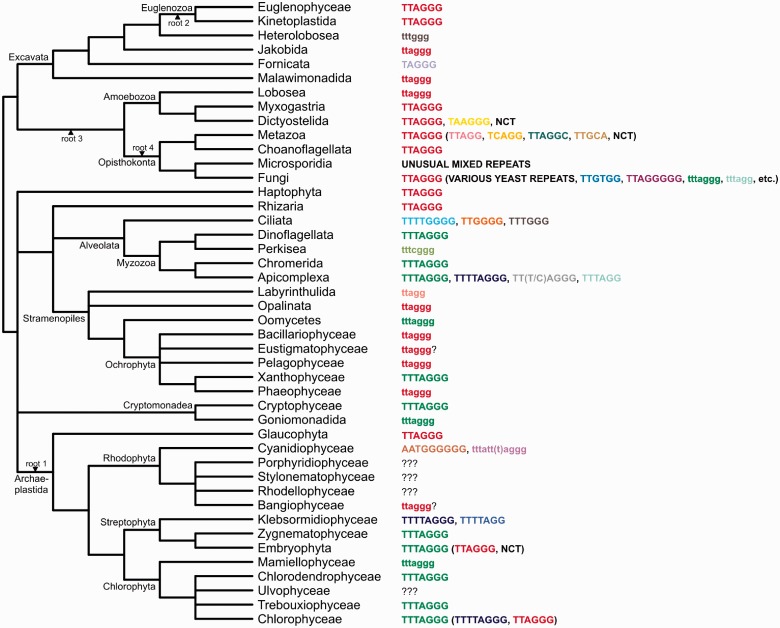Fig. 1.—
Telomeres in a framework of the eukaryotic phylogeny. The schematic phylogenetic tree of eukaryotes has been drawn based on recent phylogenomic analyses (Hampl et al. 2009; Parfrey et al. 2010; Burki et al. 2012; Derelle and Lang 2012; Laurin-Lemay et al. 2012; Zhao et al. 2012; Paps et al. 2013). Unresolved or contentious regions of the eukaryotic phylogeny are shown as polytomies; note that the supergroups “Excavata” and “Archaeplastida” are depicted as monophyletic for convenience, but monophyly of all their constituent lineages (specifically concerning the position of malawimonads and glaucophytes) remains uncertain. Lineages with no information available about their telomeres have been omitted for simplicity. Alternative, recently suggested positions of the root of the eukaryotic phylogeny are marked: root 1 (Rogozin et al. 2009); root 2 (Cavalier-Smith 2010); root 3 (Derelle and Lang 2012); root 4 (Katz et al. 2012). Telomere types documented for individual lineages are indicated on the left, with the various (putative) telomeric repeats indicated in different colors; NCT, noncanonical telomere (e.g., transposon based). Telomeric sequences confirmed by experiments or by a sufficiently complete genome sequence assembly are indicated in upper case, candidate telomeric sequences deduced from available draft genome sequences are indicated in lower case. When there is an apparently dominant telomere type known for a given taxon, the minor (typically secondarily derived) variants are shown in parentheses. For the sake of simplicity, the various unique telomeric sequences known in Saccharomycotina are indicated only by the collective label “various yeast repeats” and some of the additional unique fungal telomeric sequences are omitted (but presented in supplementary table S5, Supplementary Material online). Lineages that were targeted by experiments in this study yet failed to reveal their telomere structure are indicated with question marks. Details on the species representing the lineages in the phylogeny and the type of evidence for their telomere types are provided in table 1 and supplementary table S5, Supplementary Material online.

